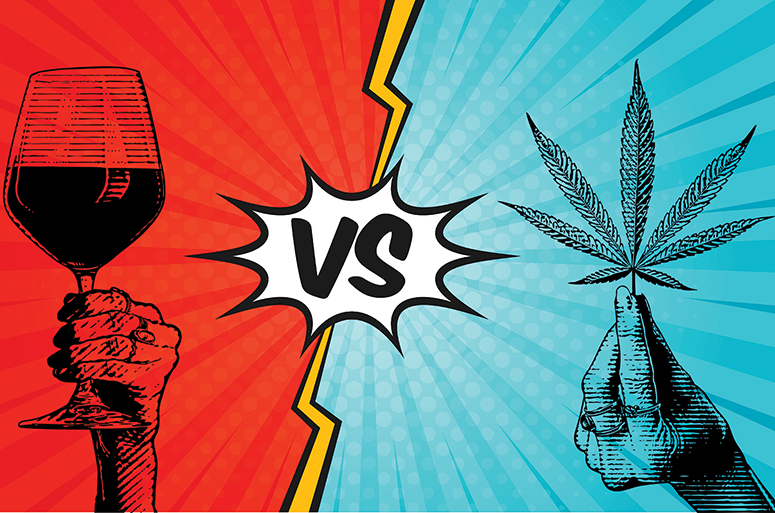Trending Articles ...
Cannabis vs. West Coast Wine
Cannabis cultivation creates resource competition and could threaten tourism in wine country—but some argue that proper regulation could benefit premier regions
By Mark Stock
The West Coast wine industry can adapt—we’ve seen it do so in response to wildfires, drought, even a pandemic. But can it handle having a new crop for a neighbor?
Cannabis farms are on the rise in and around many appellations of wine-centric states like California and Oregon; according to BDS Analytics, a Boulder, Colorado-based cannabinoid research firm, legal cannabis sales in California increased by $586 million in 2020, and the Oregon market expanded by 39 percent. They’re the expected byproduct of recent legalization and a flourishing U.S. industry, one that totaled over $17.5 billion in 2020 alone—and that’s just the legal sector.
Concerns in many regional wine communities are on the rise, too, particularly as lack of regulation creates competition for labor, illegal resource use, and skyrocketing land prices. But while some vintners and grape growers see cannabis as a threat to regional tourism, wine quality, and brand reputation, others argue that proper cannabis regulation and cultivation can actually bolster premium wine regions. Can these two crops coexist on the same turf? Or are the two highly-profitable agriculture sectors on a collision course?
Competition for Resources, Land, and Labor
Since cannabis cultivation landed in the Rogue Valley of southern Oregon, growing grapes has become far more challenging, says Michael Moore, the general manager of Quail Run Vineyards. “Everyone down here in the grape, pear, and row crop business is furious about the past couple years of totally unregulated hemp operations,” he says.
Last year was Moore’s most difficult harvest yet, and not just because of the pandemic. He and many of his colleagues had trouble getting labor during harvest, unable to compete with the cash rates offered by area cannabis grows. Moore equates the wine and cannabis duality to a pair of houses being built: The former requires permits, inspections, and taxes, while the latter is done in cash and subject to none of the scrutiny and oversight.
“The overall goal of everyone taking issue with hemp is strictly that it be regulated, and that payroll records be audited so the cash economy driving hemp and cannabis is brought into compliance as it is with the rest of agriculture,” says Moore. He and his wine colleagues simply can’t compete at the moment, losing their temp staff to the cannabis sector, which he says is offering wages nearly $10 greater per hour. “By paying cash they are avoiding state and federal taxes, social security payments, workers comp payments,” Moore adds. “The employee has no deductions, so they get the full amount.”
The regulatory concerns extend out of state and beyond the financial. In California, where cannabis has been legal since the end of 2016, wine and weed continue to tussle as each county enacts its own rules and regulations. The most extreme version of this battle has been unfolding in Santa Barbara County, where a hasty approval protocol has led to scores of giant cannabis operations in the heart of wine country, right across the road from grapevines.
Rex Stults, the vice president of industry relations at Napa Valley Vintners (NVV), is fighting for the aesthetic. Napa Valley likes to use the word “viewshed” to describe its natural surroundings, fought for long ago when mansions instead of oak-studded slopes or tidy vineyard rows started to dot the hillsides. The local wine industry moved to preserve such scenery through building regulations.
Many industry leaders from Napa have witnessed the scene in Santa Barbara. Stults says an overwhelming number of NVV members have expressed concerns about potential cannabis grows within county lines, especially if it means large greenhouses and unattractive production facilities. “We don’t want little mini prison yards popping up,” says Stults. “Wineries don’t have barbed wire or a guy on an ATV with a weapon.”
“We are solidly opposed to commercial cultivation in the county,” he adds. The NVV’s five-member board voted unanimously not to take the issue up earlier this year, meaning it would not even be discussed.
Competition for land itself is also a real concern; back in Oregon, Moore says three Rogue Valley vineyards have already sold this year, and they have been dug up and replanted as hemp farms. It costs roughly $25,000 an acre to develop a vineyard, according to Moore, and setting up an acre of cannabis tends to be even more expensive up front with the water usage and added infrastructure.
However, the profit margin is drastically different given the disparity in yields. According to a statement in the Press Democrat from Sonoma County agricultural commissioner Andrew Smith, cannabis can reach a per-acre price of $5.5 million to $6 million each year; Sonoma County wine grapes, on the other hand, were valued at $11,000 per acre in 2019.
Resultantly, Moore notes that land prices have been skyrocketing, with friends getting offered large sums of cash by cannabis investors for their properties and colossal new growing greenhouses opening up just down the road.
His concerns extend to natural resources, especially water use during increasingly dry conditions. Moore says a recent regional survey revealed that a third of hemp growers were sourcing water illegally.

“Cannabis is a premium crop that can fit into the Napa brand. We’re not talking about stereotypical stoners. We are talking about tinctures and oils.”– Stephanie Honig, Napa Valley Cannabis Association
Photograph courtesy of Adrian Gregoruti
Creating Regulatory Solutions
Others believe that with proper regulation, cannabis can not only coexist with wine, but benefit these wine regions. “We all know which way the market is heading,” says Stephanie Honig, who runs Honig Vineyard & Winery in Rutherford and is the president of the Napa Valley Cannabis Association (NVCA). “I see opportunity and a way for cannabis to benefit Napa County.”
Honig has spearheaded the Napa County Cannabis Regulation Initiative, which would amend municipal code and allow for limited cannabis cultivation within the agricultural watershed. It would impose a tax on cannabis, making it economically viable and likely ending the underground industry. Though the initiative made it onto the March 2020 ballot after Honig gathered 8,500 signatures in just one week, the organization pulled the initiative ahead of the vote because they believed the county would pass an ordinance instead; so far, that has not happened.
The NVCA’s plan involves reserving just 100 acres for cannabis in the county—all away from the viewshed—and plenty of regulation. A tax would be levied on the crop and setbacks would be put into place, including a 1,000-foot buffer between cannabis grows and any winery, vineyard, or other cultivation area. It also calls for compliance with environmental regulations like water and air quality and notes that odors may be subject to public nuisance liability.
For cannabis cultivation opponents, that isn’t enough. “Wine and weed are bad agricultural neighbors,” says Stults. “The aroma of just growing cannabis can drift for miles.” He argues that that poses a real threat for such a sensory experience as wine tasting. Though the question of whether or not cannabis odors after the chemistry and quality of wines grown nearby is still a fairly open jury, some wineries worry that unwanted terpenes will show up in their bottled products.
Both wine and cannabis growers are also worried about drift from pesticides and other vineyard sprays landing on cannabis crops; cannabis pesticide regulations are quite strict, so winery and vineyard owners could be risking expensive lawsuits.
Could Cannabis Make Wine Regions More Attractive?
Stults contends that cannabis is primarily after the Napa name, and that Napa Valley’s reputation as a scenic, high-quality wine region could be disturbed if cannabis comes to town. (Presently, cannabis growers can say “grown in Napa County” on their work but not Napa Valley.)
Honig disagrees. “Cannabis is a premium crop that can fit into the Napa brand,” she says. “We’re not talking about stereotypical stoners. We are talking about tinctures and oils.” She believes opponents’ concerns stem from insulation and the age-old fear of change. “Napa Valley wine has enjoyed double-digit growth for decades,” Honig adds.“If there wasn’t any change back in the ’60s, we’d still be growing prunes and walnuts today.”
Bringing cannabis cultivation to traditional wine regions like Napa could broaden the region’s audience, particularly among younger generations and non-wine drinkers. Honig believes that Napa as we know it isn’t beckoning millennials and Gen Z’ers to visit, but carefully-curated and experiential cannabis tourism settings could change that.
“For the Napa Valley to stay relevant and continue to be a leader in premium agriculture, we should be assessing what will be important to our consumers in 20 to 30 years and not assume consumer behavior won’t evolve from what it is today,” she says.
Projects like House of Saka—which blends Carneros Pinot Noir and Chardonnay with northern California-grown cannabis to create nonalcoholic beverages—have already attempted to demonstrate how wine and weed can coexist at a luxury level. “The feedback has been tremendously positive,” says cofounder Tracey Mason, a Napa resident who has three decades of experience as a wine industry executive. She is on the board of directors for NVCA, and she hopes to one day source cannabis for House of Saka from Napa County. “All we do is intend to honor the Napa provenance and the industry as a whole,” she says. “We’re just taking a fresh and innovative approach.”
Honig also argues that no agricultural area benefits from being a monoculture, and diverse crops can help deter plant pathogens and diseases and create a richer habitat. “From an economic perspective, a region that is dependent on one crop is much more at risk than an area with diverse income streams,” she adds. “Also, there are very few crops that would be financially viable in Napa County and cannabis is one of them.”
“Wildfires and COVID have clearly shown that wine country could benefit extraordinarily from a more diverse economic base,” adds Mason. “Cannabis is the best way to do that.”
Could premium wine regions like Napa excel in cannabis as they have in wine? “If Napa grows the best cannabis in the world, the same way we grow the best wine grapes in the world, it will add to our reputation, not tarnish it,” Honig believes.

Cannabis operations have quickly set up shop in Rogue Valley, Oregon.
Photograph courtesy of Mark Stock
Click Here to check out the article as it appeared in The Journal.


